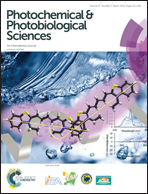Photochemical transformation of an iron(iii)–arsenite complex in acidic aqueous solution†
Abstract
Surface complexation between arsenious acid anions (As(III)) and ferric (hydr)oxides in water is important for the transformation and transfer of inorganic arsenic species. The mechanisms of formation and the photochemistry of dissolved Fe(III)–As(III) complexes in acidic aqueous solution are still unclear. Here, the photooxidation of As(III) in the presence of Fe(III) ions in acidic media has been investigated by laser flash and steady-state photolysis. At low arsenite concentrations (<1 mM), As(III) is oxidized by the ˙OH radical generated by photolysis of the FeOH2+ complex. At higher arsenite concentrations (>10 mM), photoactive Fe(III)–As(III) complexes are formed (ϕ308Fe ≈ 0.012). At all arsenite concentrations, a white FeAsO4 colloid is formed during As(III) photolysis in the presence of Fe(III) ions. Solid Fe(III)–As(III) complexes have been prepared and characterized, and the photochemical transformation of As(III) into As(V) in solid Fe(III)–As(III) complexes has been confirmed. These findings are important for a better understanding of the evolution of As(III) species under environmental conditions and should provide guidance for detoxification of As(III)-polluted water systems.


 Please wait while we load your content...
Please wait while we load your content...